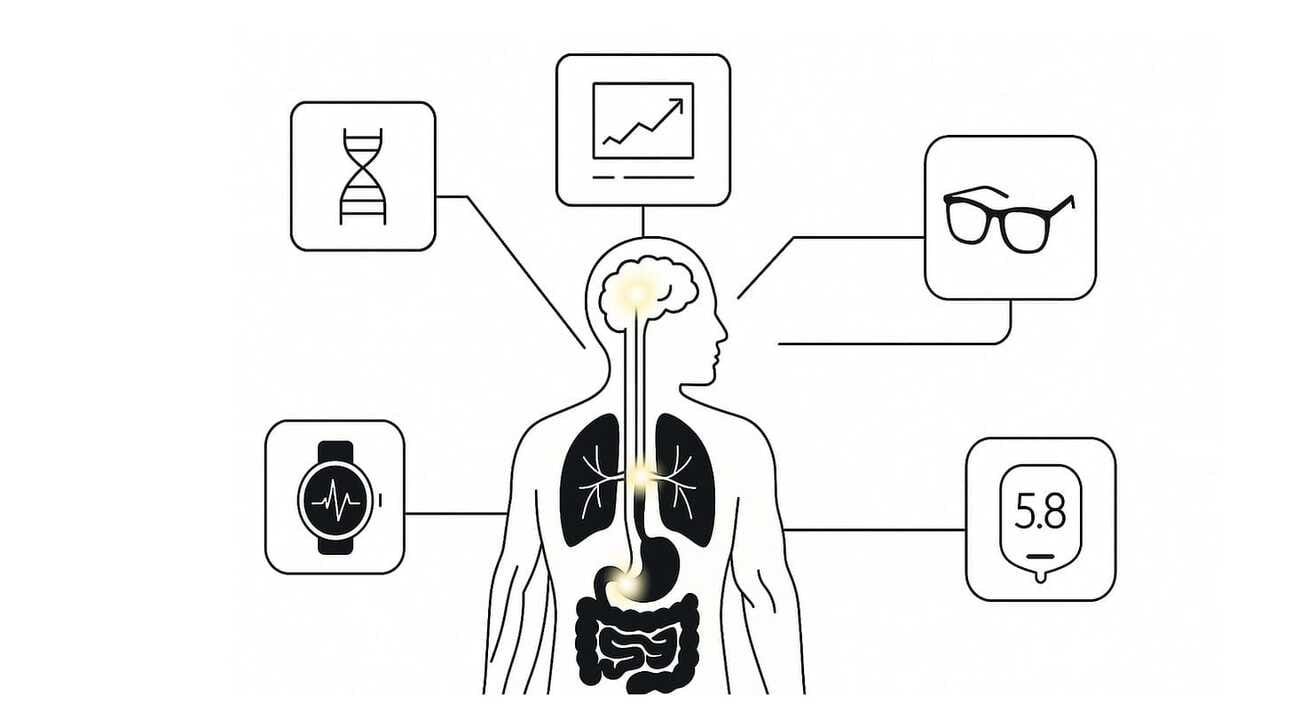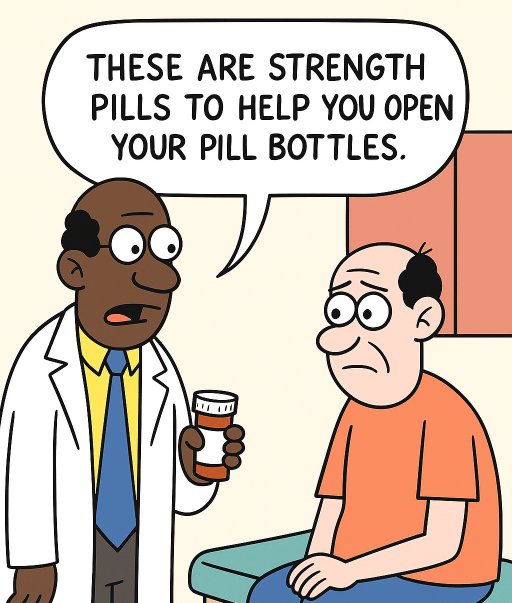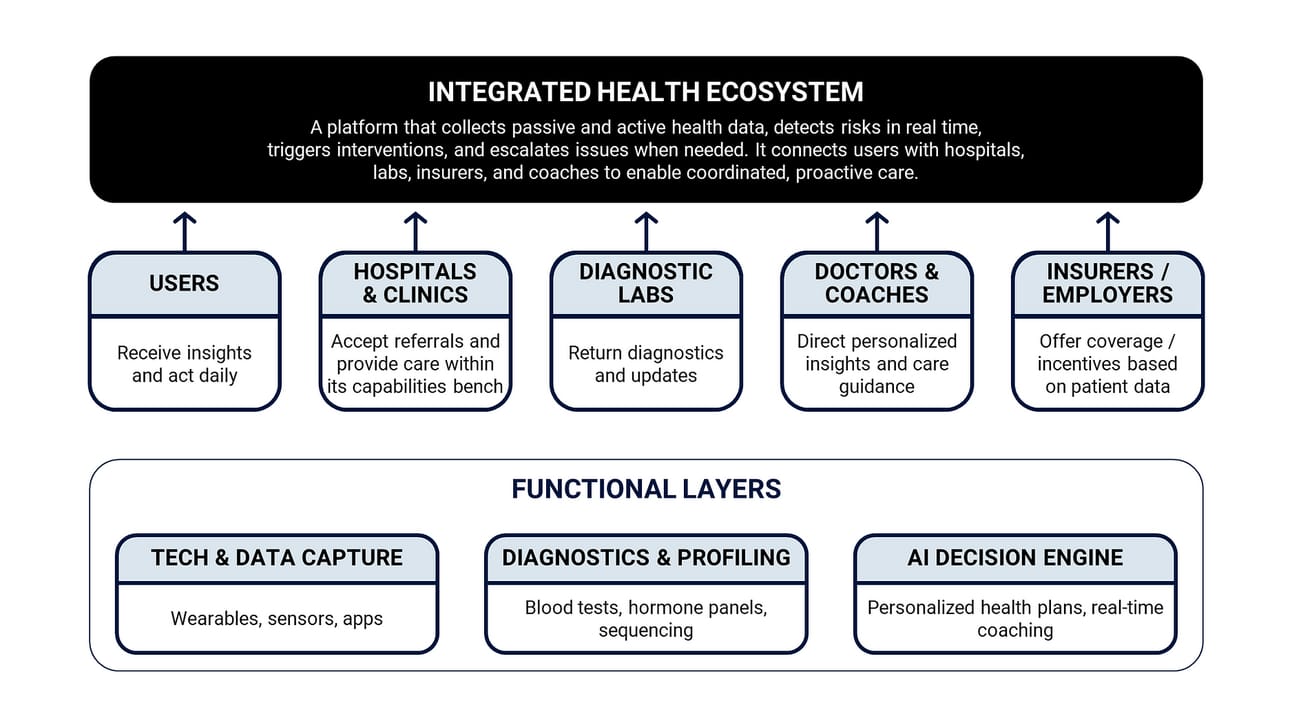- Per My Last Thought
- Posts
- The Healthcare Industry’s Inflection Point: From Reaction to Prediction
The Healthcare Industry’s Inflection Point: From Reaction to Prediction
Consumers now have access to sophisticated tools that continuously track the body’s internal state. Wearables monitor sleep, heart rate variability, and more, marking a shift from reactive to predictive healthcare models.

We’ve all lived the scene. You walk into a clinic feeling off with fatigue, a headache, or something vague. Instead of finding the root cause, you get a guess: “Take two Panadols and then let's see if you feel better.” No real-time data. Just anecdotal judgment and a static snapshot of a body in constant flux. But as data from wearables and AI converge, the consolidation of personal health information will inevitably transform healthcare – shifting it from reactive, hospital-based treatment to continuous, AI-driven care.
Healthcare is entering a period of profound structural change. For more than a century, it has been shaped around acute care, with systems designed to intervene when illness becomes visible. Clinical visits, lab tests, prescriptions, and follow-ups remain episodic in nature. This model was logical in a world where data moved slowly and diagnostics were scarce. In the current era of real-time monitoring, rapid diagnostics, and algorithmic decision-making, it no longer aligns with what is possible.
Around the individual, a new world is coming coming together. Consumers now have access to sophisticated tools that continuously track the body's internal state. Wearables monitor sleep quality, heart rate variability, oxygen saturation, and physical recovery. Continuous glucose monitors offer insights into metabolic function. Voice-based analytics identify stress patterns and cognitive fatigue. Parallel to this, lab testing is expanding to include hormone panels, immune markers, microbiome sequencing, and genetic profiling.
Interest in health optimization is no longer limited to athletes or early adopters. It is gaining traction among executives, individuals managing chronic conditions, and employers aiming to reduce healthcare costs. The demand is real. The tools are available. What remains missing is the infrastructure that brings it all together.

A New Model for Healthcare Delivery
The next evolution will not come in the form of another standalone app. What is needed is a real-time operating system for personal health – a platform that integrates continuous data, diagnostics, clinical expertise, and personalized interventions. This system will not replace physicians or hospitals. Instead, it will reshape their function, shifting them from reactive treatment providers to precision partners in an intelligent feedback loop.
The individual becomes the central node of this ecosystem. Data is captured passively through smartwatches, rings, continuous glucose monitors, sleep trackers, smart glasses, and other wearables. This data is continuously analyzed by an AI engine that establishes a personal health baseline, detects deviations, and makes micro-adjustments to the user’s plan.
Recommendations are delivered through a unified interface. These may include changes to physical activity, nutrition, sleep routines, or recovery practices. When abnormalities persist or reach clinical thresholds, the system facilitates escalation. Users are connected to diagnostics, virtual consultations, or clinics that already have access to their full health context.
An Integrated Health Ecosystem
The platform operates as a multi-sided infrastructure, linking together the primary actors in the healthcare system:
Individuals receive continuous insights, proactive support, and simplified access to care.
Hospitals and clinics serve as targeted endpoints for escalation, informed by real-time, pre-qualified data.
Diagnostic labs are embedded in the system, conducting tests and feeding results directly into personalized health profiles.
Doctors and health coaches use consolidated dashboards to refine recommendations and adjust interventions.
Insurers and employers participate through preventive programs that reduce claims and improve workforce wellbeing.
Technology and functional layer which include devices, sensors, and diagnostics via standardized integrations.

The platform generates value through multiple streams, including subscription models for users, enterprise contracts with employers and insurers, partner fees from labs and providers, and optional premium services such as personalized supplement programs, hormone optimization, or focused longevity protocols.
Continuously Plugged-In – Shifting from Static to Dynamic Care
The most significant transformation lies in moving from episodic snapshots to continuous health streaming. Traditional medicine relies on sparse, delayed data. A routine doctor visit captures a few minutes of information. A blood test might reflect conditions that have already changed. Diagnosis is often reactive, triggered by patient complaints rather than early detection.
In a continuous model, the platform identifies subtle deviations before they escalate. It adjusts behavior in real time. It prevents avoidable conditions. And when intervention is necessary, it enables faster, more precise care. This model improves outcomes, reduces hospital load, and lowers long-term costs. It also empowers the individual to be an informed, engaged participant in their own health journey.
This transformation is already underway. Several forces are accelerating the transition. The first platform to integrate them into a seamless system will not simply gain market share. It will redefine how society thinks about health, creating a new interface between humans and their biological data.
The cost and accuracy of biometric devices have improved dramatically, making large-scale adoption viable.
Healthcare systems and insurers face rising costs from preventable conditions, creating strong financial incentives for early intervention.
Consumers have grown comfortable with digital health tools and are open to continuous engagement when the experience is intuitive and helpful.
Global technology firms are strategically positioning themselves in the health space. Apple continues to embed medical-grade features into its hardware. Amazon is expanding into pharmacy, diagnostics, and care coordination. Google owns Fitbit and is developing AI-based health models. OpenAI is exploring behavior-aware agents that could one day manage individual health routines.
So What Does This Mean?
This future will not eliminate traditional healthcare, but it will reframe its role. Primary care will become one tier within a broader, data-driven system. Hospitals will focus on acute interventions and advanced treatment. Physicians will shift from periodic check-ins to real-time guidance supported by a continuous stream of biometric intelligence.
Over the next decade, healthcare will evolve from a fragmented service industry to an integrated, adaptive infrastructure. It will be shaped by personalization, continuity, and prevention rather than delay, fragmentation, and reaction. For the first time, health will not be something people think about only when it fails. It will become a quiet, constant presence – protecting, guiding, and adjusting in the background. A transformation long overdue, and now finally within reach.
Let’s Imagine The Near Future Together
It is early morning in 2032. You wake up to the faint pulse of your smart ring syncing with your home dashboard. Overnight data shows elevated inflammation and mild respiratory changes. Based on this, your system adjusts the day ahead. A cold shower replaces your scheduled high-intensity session. A high-protein breakfast is suggested to stabilize energy. Meetings are rescheduled slightly to allow for a short breathing session under circadian lighting.
Your glasses confirm healthy posture and daylight exposure as you move through your routine. Blood biomarkers from a test conducted two days ago automatically update your micronutrient intake. Subtle dietary changes are applied. Later in the evening, a cognitive fatigue signal triggers an earlier bedtime. The system dims your environment, blocks alerts, and adjusts caffeine intake for the next day.
You don’t open an app. You don’t manage a schedule. You live, and the system works around you. The question I ask myself however, is when this reality will take place, will we miss the chaos? The uncertainty? The art of guessing... And I wonder if, in trading gut instinct for algorithmic clarity, we gave up something we never quite measured? ... our humanity.